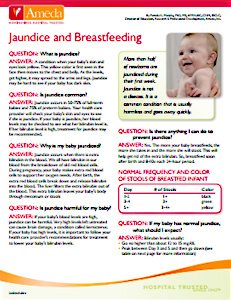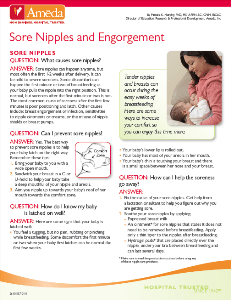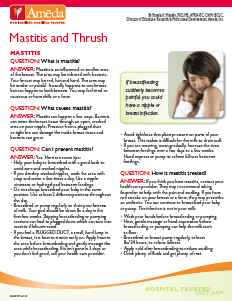Common Breastfeeding Problems and Solutions
Learn more about common challenges breastfeeding mothers and their babies face, as well as solutions. Overcoming challenges throughout your breastfeeding journey is easier when you have support. That’s why it’s important to build your breastfeeding support network.
Jaundice is a yellow color in the skin. It happens when a yellow pigment called bilirubin builds up in the blood and seeps into the skin. Bilirubin is made when the extra red blood cells babies are born with are broken down. When jaundice is mild, no treatment is needed.There are different causes of newborn jaundice. Your baby’s age when the jaundice first appears is a clue to its cause.
Your baby’s healthcare provider will check his skin color under good light. The yellow color is first seen in the face. Then it moves to the chest and belly. As the levels get higher, it may spread to the arms and legs. You may also see it in the whites of your baby’s eyes. Jaundice can be harder to see if your baby has dark skin.
BILIRUBIN LEVELS
Though safe levels of bilirubin may be good for babies, severe jaundice can be harmful. In a few babies, very high levels have caused brain damage (called “kernicterus”). That’s why your baby needs to be checked to be sure the jaundice stays within safe levels.
- Go no higher than about 12 to 15 mg/dL
- Peak between Day 3 and 5 and then go down
First Day or Two
Jaundice appearing now has a physical cause, such as:
- Differences in blood types or Rh factors between mother and baby
- Infection or illness
- Metabolic disorder
- Bowel blockage
For the jaundice to go away, the baby’s health problem must be treated.
Day Three or Four
Jaundice appearing now is the normal type. Unlike adults, newborns:
- Make more bilirubin
- Process it slowly
- Absorb it easily through the gut
As babies mature, they can process the bilirubin faster and the jaundice goes away.
Continuing after the First Week
Most breastfed babies have higher bilirubin levels than babies fed formula. This is true for weeks and even months. Bilirubin is an antioxidant, and research indicates that safe levels may actually be good for babies.
- If a baby had more severe jaundice at first, it may stay higher for longer.
- As long as baby is low risk and levels stay below 20 mg/dL, jaundice is considered harmless.
RISK FACTORS
Jaundice is usually harmless when it stays below 20 mg/dL. But treatment may need to start at lower levels if your baby has the following risk factors:
- Jaundice on Day 1
- Born more than two weeks early
- Illness or infection
- Levels rising quickly
- Lots of bruising or bleeding under the scalp
- Not breastfeeding well
BREASTFEEDING AND JAUNDICE
Most cases of jaundice don’t need to be treated. Simply breastfeeding often may be all that’s needed. But if that is not enough, the first step is to help the baby take more milk at each feeding.
- Help your baby take the breast deeper in his mouth.
- Compress or massage the breast during feedings to speed milk flow.
- Breastfeed at least 10 to 12 times per day.
- To spur your baby to feed more, lean back and lay him tummy down on your body with his torso skin to skin with yours.
- Guide your baby to the breast when he is drowsy or in a light sleep.
- Avoid giving water, which may make jaundice worse.
- Avoid pacifier use. If all sucking is at the breast, your baby gets more milk.
If your baby is not breastfeeding well, pump your milk and feed it to him. Talk to a board-certified lactation consultant for advice on how to give your baby extra milk.
Your milk is usually the first choice, but if you can’t express enough milk, talk to your healthcare provider about feeding donor milk or formula. You may need to supplement for a short time until your milk catches up to your baby’s need. Until your baby is getting the milk needed at the breast, use a multi-user, hospital-grade breast pump at least 8 times a day and double-pump for at least 10 minutes each time to boost your milk production.
Preventing Sore Nipples – Start with a Deep Latch
Tender and sore nipples at the start of breastfeeding are normal during the first week or two. But pain, cracks, blisters, and bleeding are not. Your comfort depends on where your nipple lands in your baby’s mouth. And this depends on how your baby takes the breast, or latches on. To understand this better, use your tongue to feel the roof of your mouth. Behind your teeth are ridges. Behind the ridges the roof feels hard. When your nipple is pressed against this hard area in your baby’s mouth, it can hurt.
But farther back in your mouth the roof turns from hard to soft. Near this is the area some call the comfort zone. Once your nipple reaches your baby’s comfort zone, breastfeeding feels good. There is no undue friction or pressure that would cause sore nipples during breastfeeding.
To make this happen, let gravity help. Lean back with good neck, shoulder, and back support and your hips forward. Lay your baby tummy down between your exposed breasts. When your calm, hungry baby feels your body against her chin, torso, legs, and feet, this triggers her inborn feeding reflexes. When her chin touches your body, her mouth opens and she begins to search for the breast. In these laid-back positions, gravity helps the nipple reach the comfort zone.
In other positions, you need to work harder to help your baby take the breast deeply.
- With your baby’s body pressed firmly against you and her nose in line with your nipple, let her head tilt back a bit (avoid pushing on the back of her head).
- Allow her chin to touch the breast then move away.
- Repeat until her mouth opens really wide, as wide as a yawn.
- As she moves onto the breast chin first, gently press between your baby’s shoulders from behind for a deeper latch.
That last gentle push helps the nipple reach the right spot. Breastfeeding tends to feel better when your baby latches on asymmetrically, so that more of the areola (the dark part around your nipple) under the nipple is in her mouth than on top of the nipple.
Signs of a Deep Latch
- You feel a tugging but no pain throughout the breastfeeding session. (In the first week or so you may feel some pain in the first minute or two of sucking that eases quickly)
- You hear your baby swallowing.
- Her lower lip is rolled out.
- You see more of the dark area around the nipple above your baby’s upper lip than below.
- Your baby breastfeeds with a wide-open (not a narrow) mouth.
If breastfeeding hurts, seek help right away from a board-certified lactation consultant (IBCLC). The sooner you get help, the better.
Solutions for Sore Nipples
If you have painful, sore nipples during breastfeeding (beyond the first minute or two of discomfort that sometimes occurs) you need to take your baby off the breast and try for a better latch. Be sure to break the suction first. Gently slide a clean finger between baby’s lips and gums until you feel the suction release.
Even mothers with broken skin on their nipples can heal while breastfeeding. When their nipples reach the comfort zone, there is no friction and pressure.
If your breasts are very full and taut, it may help to express a little milk first. It is easier for a baby to draw a soft breast back to the comfort zone than a firm, full breast.
If after working to get a deeper latch, you aren’t feeling better within a day or two, seek help from a board-certified lactation consultant. Other solutions may be needed with other causes of nipple pain.
If you have broken skin on your nipples, products that provide a healthy moisture balance will soothe and speed healing. Mothers were once told to keep their nipples dry, but now moist wound healing is recommended. Helpful products include:
Ameda ComfortLanTM 100% Pure Lanolin. ComfortLan soothes tender, sore nipples. Medical-grade, ultra-purified, USP-modified lanolin. For best results, apply a pea-sized amount between fingers and apply to nipple area after each breastfeeding or as needed.
Ameda ComfortGelTM Extended-Use Hydrogel Pads. These provide relief from soreness by soothing, cooling, and protecting nipples. They provide the moist wound healing environment hospitals recommend for optimal healing. They are worn in the bra like a breast pad between feedings and/or pumpings.
A few days after your baby’s birth, your milk production increases or comes in. It is normal to feel some breast fullness, but engorgement, which can happen during the first week after birth, goes beyond normal fullness. When a mother is engorged, her breasts become full, firm, hard, hot, and sometimes painful.
Some think breast engorgement is caused by too much milk. But it is really caused by fluid build-up in the breast. If the milk is not drained often and well, extra blood, lymph, and other fluids build-up in the breast, too. Lots of IV fluids during labor can also be a factor.
TO PREVENT ENGORGEMENT:
- From birth, breastfeed at least 8-12 times a day. If the baby is not feeding well, use a multi-user, hospital-grade breast pump to drain the breasts this often.
- Be sure when breastfeeding that your baby latches on deeply. This feels better for you and helps your baby drain the breast more fully.
- Avoid bottles and pacifiers. Keep your baby at the breast for all sucking.
TO TREAT BREAST ENGORGEMENT:
- Discuss with your healthcare provider taking ibuprofen to relieve swelling.
- If needed, express some milk before feeding to make it easier for your baby to latch deeply.
- Apply warmth right before feeding to aid milk flow.
- Breastfeed at least every 1.5-2 hours during the day and at least every 2-3 hours at night until engorgement is gone.
- Use breast massage or compression during feedings to more fully drain your breasts.
- Let warm water run over your breasts in the shower. Leaking relieves pressure.
- If your breasts still feel full after feedings, pump to drain your breasts fully.
- Express milk to comfort between feedings.
- Apply cold—gel ice packs or bags of frozen peas, wrapped in cloth—after feedings for 10-15 minutes to reduce swelling.
Try applying green cabbage leaves to your breasts between feedings to help reduce pain and swelling. To do this, put a chilled cabbage leaf in your bra for 15-30 minutes two to three times per day. Avoid cabbage if you are allergic to it or if you develop a skin rash.
Be sure to treat breast engorgement before it gets painful. Severe pressure and swelling can cause breast damage. If these methods do not provide relief, seek help right away from a board-certified lactation consultant or other knowledgeable healthcare provider.
Mastitis is an inflamed or swollen area in the breast. This swelling prevents the milk from flowing freely. With a mild case of mastitis, a mother may feel a small lump. With a more severe case, a large area of the breast may feel swollen or hard. The swollen area may feel tender or painful and it may look red. It may hurt to breastfeed. Most often only one breast is affected. But in rare cases may occur in both breasts. A mother with mastitis may or may not run a fever.
THE THREE MOST COMMON CAUSES OF MASTITIS ARE:
- Broken skin on the nipple that allows organisms to enter the breast.
- Inside pressure from a very full breast.
- Outside pressure on the breast over time from a too-tight bra, swimsuit, or strap that presses into the breast.
RISK FACTORS FOR MASTITIS INCLUDE:
- Overabundant milk production, which may often leave the breasts feeling full.
- Diabetes, which puts mothers at higher risk for infections of all kinds.
- Feeling very run down.
WHAT SHOULD YOU DO IF YOU HAVE MASTITIS?
First, contact your healthcare provider. Ask about taking ibuprofen to reduce the swelling. If you are fever free or have a low-grade fever, your healthcare provider may suggest treatments for mastitis.
- Breastfeed often—every 1.5 to 2 hours during the day and at least every 3 hours at night.
- Use breast massage while feeding to help the baby more fully drain the breast.
- If that breast still feels full after breastfeeding, express more milk from it.
- Apply warm compresses to the swollen area 3-4 times a day for 10-15 minutes. It can take up to a week for the swelling to go away. If you are improving, you should feel less swelling every day.
If you notice any of the following at any time before or during treatment for mastitis, contact your doctor right away. He or she may prescribe an antibiotic if:
- You do not feel any better within a day or two.
- You have a fever of 101°F (38.4°C) or higher.
- You see red streaks on your breast, it is feeling hotter, or the swelling is getting worse.
- You feel achy and have chills.
Nipple yeast and thrush – or candidiasis – refers to an overgrowth of yeast in mom and baby. It is not serious, but it may cause discomfort or pain for mother and baby.
Signs of Nipple Yeast
Only your healthcare provider can diagnose nipple yeast and thrush. If you have it, you may have one or more of the following signs:
- Itchy, burning nipples.
- Flaky nipple skin.
- Bright pink skin on the breast where baby’s mouth touches during feedings.
- Shooting pains in the breast during or after breastfeeding.
- Symptoms of a vaginal yeast infection.
Your baby may have one or more of the following signs:
- Creamy looking white areas inside the mouth.
- A film in the mouth on gums or tongue.
- Diaper rash with raised patches or shiny skin in the diaper area.
- Sudden feeding problems, pulling off or crying.
- Gassiness or colic.
Treatment of Nipple Yeast
Nipple yeast and thrush is only one of many common skin problems caused by an overgrowth of yeast. You may be more likely to develop nipple yeast and thrush if you or your baby have recently taken antibiotics, you have a history of vaginal yeast infections, you have diabetes, or if you have broken skin on your nipple. Your healthcare provider will need to treat both you and your baby with an antifungal medication, such as:
- A prescribed or over-the-counter product to apply to your nipples.
- A solution to swab inside your baby’s mouth after every feeding.
- An ointment or cream for his diaper area.
- A drug you swallow.
Nystatin has been prescribed for thrush for many decades. Unfortunately, it does not work as well as it once did. Today, 40% of those treated with Nystatin do not get better. But there are other antifungal drugs that work very well.
Keep breastfeeding while you and your baby are being treated. To reduce pain, start on the least sore breast first and switch breasts after your milk begins flowing. With the right treatment, the pain should be almost gone within three to seven days. If not, tell your doctor and ask about another treatment.
If needed, ask your lactation consultant to share details on other over-the-counter, herbal and alternative treatments with you and your doctor.
What You Can Do to Prevent Nipple Yeast and Thrush From Returning:
Yeast is hardy and can grow in many places. While you and your baby are being treated:
- Boil daily for 20 minutes anything that goes in baby’s mouth (such as bottle nipples, pacifiers, teething toys), anything your baby sucks on or chews, and any breast pump parts that touch the milk.
- Wash hands often—both yours and your baby’s.
- If you use nursing pads, use the disposable kind and replace often.
- Be sure to follow the treatment for the recommended time.
This is general information and does not replace the advice of your healthcare provider. If you have a problem you cannot solve quickly, seek help right away.
Get My Insurance Covered Pump
Complete our online form and we'll take care of the rest!



